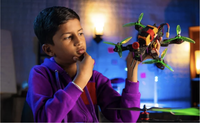The education industry was already in the throes of digital disruption—but no student, teacher, or institution had prepared for a pandemic coming. Yet as billions of students around the world were told to stay at home, the traditional classroom has had no choice but to transform. Suddenly, institutions of all sizes must now think and act like digital e-learning platforms. We’ve seen an explosion in remote education across all levels of education as video calling helped keep learning alive and entire school systems running during lockdowns. But distance learning via video is only one part of the education journey. Now, educational organizations must rethink and upgrade their student engagement to meet the permanent shift in consumer behavior and expectations.
The world has changed, but one thing hasn’t. Education providers must listen to and connect with customers on their terms to continue to win them over and build lasting relationships. This means not just getting the messages right, but also being available to students on all the right channels, at all the right moments. As consumers’ switch to digital is accelerated, it’s never been more critical to stay ahead.
To help guide your student engagement decisions now and into the future, our partner Vonage surveyed 5,000 consumers across 14 countries in January 2020 before the pandemic, and again in August—in their 10th Annual Global Customer Engagement Report—to find out how much has changed and to understand how consumers want to connect with organizations like yours. Here are 4 key customer engagement insights and challenges revealed in the findings—and a training plan to help you achieve a winning CX in education in 2021.
Deliver quality and reliable remote learning to students anywhere consumers continue to embrace video to engage with other students and teachers—preferring video calling 1.2x more today than before the pandemic. When schools and universities were shut down around the world, distance learning via live video became a lifeline between teachers and students. Many educators turned to off-the-shelf, general-purpose video conferencing tools. These tools provided an immediate solution, but now that remote education is a permanent reality, how can institutions create immersive, collaborative video experiences in the context of students’ learning environments, free from distractions and quality limitations?
The pandemic intensifies student expectations for an omnichannel experience. No matter where they are in the world, students are connecting on all their favorite channels, and their preferences are in a constant state of flux. From WeChat to WhatsApp, Facebook Messenger to Line, it’s difficult to know where your students will look to reach you or where to effectively engage with them beyond the classroom. When we asked students how they prefer to receive and reply to updates such as timetable changes, learning reminders, and study tips, a puzzle of preferences emerged:
16% prefer voice
16% prefer video chat
21% prefer SMS
19% prefer messaging including social apps
Build stronger student relationships with seamless conversations. When students learn with your organization, they trust their information is correctly and securely shared among the right people. The fastest way to break this trust is to make them repeat themselves to different people across the learning experience—teachers or administration staff. But without a complete view of the student—and the history of their conversations—how can educational providers prevent this critical engagement flaw?
Protect your platform and make validation seamless. It’s a fine balance between preventing fraud and reducing friction. As online learning continues to grow, getting it right could separate the winners from those that get left behind. If you’re not using SMS to validate students, chances are you're frustrating a new customer before their journey has even begun.
The Communication building blocks for high performing CX. Delivering outstanding customer engagement is like competing in the decathlon—a multidisciplinary challenge played out over time, across dozens of touchpoints and channels. It’s the combined performance of all customer interactions that ultimately sets you apart and wins the adoration of your fans.
About the author
Robert Iskander is a global business transformation leader passionate about leveraging technology to improve the quality of life for all, with a special focus on K-12 education and was nominated as one of the Top 100 EdTech Influencers in 2017 by EdTech Magazine. Prior to his current role as CEO at GG4L, Robert had several corporate leadership roles over the past 30 years, including General Manager of Sun Microsystems in the Middle East and Global Director of Education at Sun Microsystems (now Oracle). He also ran SchoolMessenger for several years and grew its customer base to 63,000 schools in the US and Canada.











